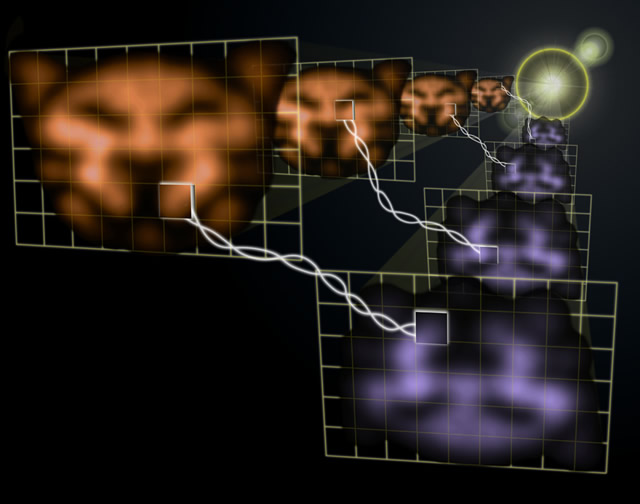Jun 28 2011
Using a convenient and flexible method for creating twin light beams, researchers from the National Institute of Standards and Technology (NIST) and the University of Maryland (UM) have produced “quantum images,” pairs of information-rich visual patterns whose features are “entangled,” or inextricably linked by the laws of quantum physics.
 In this photo montage of actual quantum images, two laser beams coming from the bright glare in the distance transmit images of a cat-like face at two slightly different frequencies (represented by the orange and the purple colors). The twisted lines indicate that the seemingly random changes or fluctuations that occur over time in any part of the orange image are strongly interconnected or �entangled� with the fluctuations of the corresponding part in the purple image. Though false color has been added to the cats� faces, they are otherwise actual images obtained in the experiment.
In this photo montage of actual quantum images, two laser beams coming from the bright glare in the distance transmit images of a cat-like face at two slightly different frequencies (represented by the orange and the purple colors). The twisted lines indicate that the seemingly random changes or fluctuations that occur over time in any part of the orange image are strongly interconnected or �entangled� with the fluctuations of the corresponding part in the purple image. Though false color has been added to the cats� faces, they are otherwise actual images obtained in the experiment.
In addition to promising better detection of faint objects and improved amplification and positioning of light beams, the researchers’ technique for producing quantum images—unprecedented in its simplicity, versatility, and efficiency—may someday be useful for storing patterns of data in quantum computers and transmitting large amounts of highly secure encrypted information. The research performed at the NIST/UM Joint Quantum Institute (JQI) was described in the June 12 edition of Science Express.*
Conventional photographic films or digital camera sensors only record the color and intensity of a light wave striking their surfaces. A hologram additionally records a light wave’s “phase”—the timing the crests and valleys in the wave. However, much more happens in a light wave. Even the most stable laser beam brightens and dims randomly over time because light has inherent quantum level “uncertainties” in its properties. Controlling these fluctuations—which represent a sort of “noise”—can improve detection of faint objects, produce better amplified images and allow workers to more accurately position laser beams. Researchers can’t completely eliminate the noise, but they can rearrange it to improve desired features in images. A quantum-mechanical technique called “squeezing” lets physicists reduce noise in one property—such as intensity—at the expense of increasing the noise in a complementary property, such as phase. In addition to noise reduction, the quantum manipulations open new applications for images—such as transferring heaps of encrypted data protected by the laws of quantum mechanics and performing parallel processing of information for quantum computers.
The quantum images produced by the JQI team are in “entangled” pairs, transmitted by two light beams originating from the same point. Look at one quantum image, and it displays random and unpredictable changes over time. Look at the other image, and it exhibits very similar random fluctuations at the same time, even if the two images are far apart and unable to transmit information to one another. Together, they are squeezed: Matching up both quantum images and subtracting their fluctuations, their noise is lower—and their information content potentially higher—than it is from any two classical images. Each image is made of up to 100 distinct regions, akin to the pixels forming a digital image, each with its own independent optical and noise properties. A pixel on one image forms a partnership with a pixel on the other image—one could predict many of the properties in the second pixel just by looking at the first.
Previous efforts at making quantum images have been limited to building them up with “photon counting”—collecting one photon at a time over a long period of time—or having very specialized “images” such as something that could only be constructed from a dot and a ring. In contrast, the new method produces an entire image at one time and can make a wide variety of images in any shape. A next goal for the researchers is to produce quantum images with slowed-down light; such slowed images could be used in information storage and processing as well as communications applications.
* V. Boyer, A. Marino, R. Pooser, and P. Lett. Entangled Images from Four-Wave Mixing. To Appear in Science Express, 12 June 2008.
Source:
The National Institute of Standards and Technology (NIST)